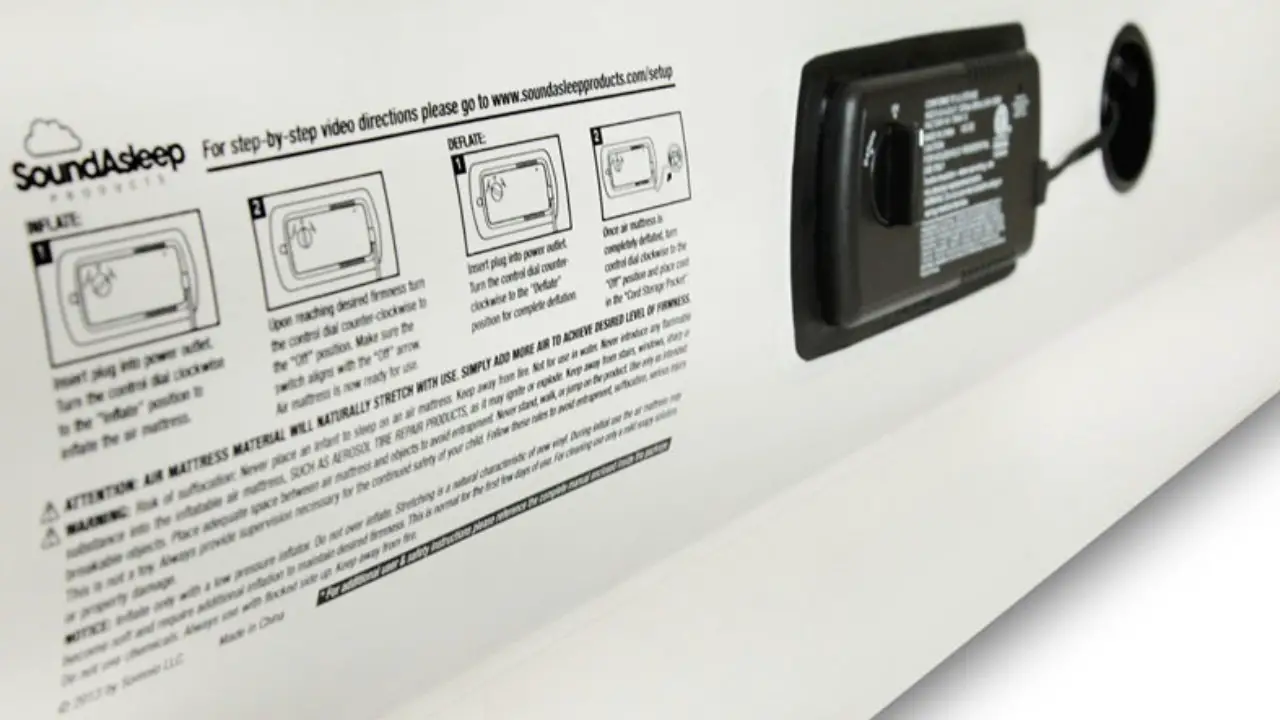Air beds deflate due to various reasons, such as leaks, temperature changes, and pressure adjustments. When air escapes through small holes or weak seams, the bed slowly loses air pressure, causing it to deflate.
Unveiling Why Air Beds Deflate
Understanding the reasons behind air bed deflation can help you prevent unexpected disruptions during sleep. Air mattresses, commonly used for camping or as temporary bedding options, incorporate a unique design that involves air-filled chambers. Over time, a variety of factors can contribute to deflation, such as:
- Maintenance: Properly maintaining air beds through regular inspections and occasional reinflations is crucial. Environmental conditions, temperature fluctuations, and usage frequency can affect air pressure and lead to gradual deflation.
- Material Quality: The integrity of the mattress material plays a vital role in preventing leakage. Checking for punctures, tears, or faulty valves is essential to address potential sources of deflation.
- Weight Distribution: Uneven pressure distribution caused by concentrated weight, excessive force, or improper positioning can strain the air chambers, leading to deflation.
Despite common misconceptions, air bed deflation does not necessarily indicate a defect or poor quality. By adhering to regular maintenance practices and being mindful of weight distribution, you can enjoy a restful night’s sleep on your air bed for years to come.
Air Bed Materials And Valve Systems
| Material | Description |
|---|---|
| Nylon | Durable and lightweight |
| PVC | Relatively affordable and puncture-resistant |
| Vinyl | Waterproof and easy to clean |
Temperature And Pressure Effects
Temperature and pressure fluctuations play a significant role in the deflation of air beds. As the temperature changes, the air inside the bed expands or contracts, causing changes in air density. When the temperature rises, the air molecules gain energy and move faster, leading to an increase in pressure. This results in the expansion of the air bed, potentially leading to the release of some air and subsequent deflation. Conversely, when the temperature drops, the air molecules lose energy and move slower, resulting in a decrease in pressure. This reduction in pressure causes the air bed to contract, leading to further deflation. Additionally, there is a direct relationship between atmospheric pressure and deflation. As atmospheric pressure decreases, the air inside the bed pushes against the lower external pressure, causing the air bed to lose air and deflate. It is important to understand these temperature and pressure effects to properly maintain and inflate air beds. Keeping the bed away from extreme temperature conditions and ensuring a stable atmospheric pressure is crucial in preventing deflation and ensuring a comfortable sleep experience.
Proper Inflation Techniques
When it comes to air beds, proper inflation ensures comfort and durability. Identifying the right inflation level is crucial, as an underinflated air bed can cause discomfort while an overinflated one may lead to leaks or bursts. To achieve the ideal inflation, consider using tools and pumps specifically designed for air bed inflation.
Tools And Pumps For Ideal Air Bed Inflation
| Tool/Pump | Description |
|---|---|
| Air Mattress Pump | An electric pump specifically created for inflating air beds. It ensures efficient inflation and can be adjusted to achieve the desired firmness. |
| Manual Pump | A hand-operated pump that allows for easy inflation and better control over the inflation process. It is suitable for users who prefer a more hands-on approach. |
| Pressure Gauge | A tool to measure the air pressure inside the mattress. It helps in identifying the ideal inflation level and prevents over or underinflation. |
Body Weight And Distribution
The impact of body weight on air mattress deflation is a key factor to consider when understanding why air beds deflate. The way weight is distributed on an air mattress can greatly affect its ability to hold air over time. As weight is applied to the mattress surface, the air inside is compressed, causing air leakage through seams, valves, or other weak points. This means that heavier individuals may experience more frequent deflation compared to lighter individuals. The significance of weight distribution while sleeping is crucial in preventing air bed deflation. When a person lies on an air mattress, the weight is unevenly distributed, putting additional pressure on specific areas. This concentrated pressure can lead to more air leakage and faster deflation of the mattress. Proper weight distribution can be achieved by using additional support layers such as foam to evenly distribute the body weight across the mattress surface.
Deflation Over Time And Usage
One common concern with air beds is their tendency to deflate over time and with regular usage. Air mattresses are designed to be portable and convenient, but their construction makes them susceptible to gradual air loss. This can be attributed to a few factors:
- Fabric and Material Quality: Poor-quality materials or fabrics used in the construction of an air bed can result in tiny perforations or leaks that lead to air loss.
- Temperature and Environment: Changes in temperature and environmental factors like humidity can impact the air pressure within the bed, causing it to deflate slightly.
- Usage Frequency and Weight Distribution: Frequent or heavy usage of an air mattress can put strain on the seams, valves, or air chambers, leading to air leakage over time.
While it is normal for air beds to experience some expected air loss due to these factors, adequate maintenance and precautions can help minimize deflation issues. Regularly checking for leaks, properly storing the air bed, and avoiding sharp objects can contribute to its long-term durability. In conclusion, understanding why air beds deflate over time and usage allows users to better manage their expectations and take appropriate measures to maintain the mattress’s performance.
Avoiding Common Deflation Pitfalls
There are several reasons why air beds deflate, but by following a few best practices, you can avoid common deflation pitfalls and extend the lifespan of your air bed. First, always make sure to properly secure the valve after inflating the bed to prevent any air from escaping. Additionally, avoid over-inflating the bed as this can put extra strain on the seams and increase the risk of leaks. Regularly inspect your bed for any signs of damage, such as punctures or worn-out seams, and promptly repair them to prevent further deflation. It is also important to store your air bed properly when not in use, keeping it in a clean and dry environment away from sharp objects. Lastly, consider using a mattress topper or protective cover to provide an extra layer of defense against punctures and extend the lifespan of your air bed.
- Ensure that the valve is tightly closed and not damaged
- Avoid placing heavy objects on the bed
- Keep the bed away from direct heat sources
- Use a mattress topper or protective cover

Patching And Maintaining Air Beds
Leaky air beds can be a frustrating issue, causing discomfort while you sleep. Fortunately, by following a step-by-step guide, you can easily locate and patch leaks in your air bed to prevent deflation. Firstly, before starting any repair work, ensure that the air bed is completely deflated. Next, check for obvious signs of leakage such as hissing sounds or deflation points. To detect smaller leaks, you can use a spray bottle filled with soapy water and spray it over the mattress surface while pressing down. Bubbles will form where the leaks are located. Once the leaks are identified, clean the area around each leak using rubbing alcohol. Then, apply a vinyl patch or a reliable adhesive specifically designed for air bed repairs. Press the patch firmly onto the leak area and allow it to cure according to the instructions provided by the manufacturer. To avoid frequent repairs and prevent air bed deflation in the future, it is important to establish maintenance routines. Regularly inspect the mattress for any signs of wear and tear. Avoid placing the air bed on rough or sharp surfaces that could puncture it. Additionally, be mindful of the weight limit specified for your air bed to prevent excessive pressure on the seams and valves. Properly deflate and store the air bed when not in use, ensuring it is clean and dry before storing. By implementing these maintenance habits, you can extend the lifespan of your air bed and enjoy uninterrupted sleep.
Puncture Risks And How To Mitigate
Air beds can deflate due to a variety of reasons, including punctures. Identifying external factors that can lead to punctures is crucial in order to prevent deflation. These factors can range from sharp objects in the surrounding environment to excessive weight applied on the bed. To mitigate the risk of punctures, it is important to take preventative measures. One effective way is to carefully inspect the area where the air bed will be placed, removing any sharp objects or debris. Additionally, using a protective cover or placing a thick blanket or mat underneath the bed can provide an extra layer of defense against punctures. Furthermore, paying attention to the weight limit of the air bed and refraining from placing excessive weight on it can reduce the likelihood of punctures. It is also recommended to avoid jumping or bouncing on the bed, as this can create undue strain and potentially lead to deflation. By being proactive in identifying potential puncture risks and implementing preventative measures, you can help ensure the longevity and durability of your air bed.
Troubleshooting Deflation Issues
Assessing your air bed for unseen problems is essential to understanding why it deflates. Start by thoroughly inspecting the mattress for any visible punctures, tears, or worn areas. Carefully examine the seams and valves for signs of leakage. If you notice any, patching or sealing may be necessary. If the bed appears to be in good condition, it’s possible that the deflation is caused by an issue with the pump or valve. Check that the valve is tightly closed and properly sealed. If the valve is damaged, it may need replacement. When determining whether to repair or replace an air bed, consider the extent of the damage and the age of the bed. If the damage is minor and the bed is still relatively new, repairing it may be a cost-effective solution. However, if the bed is old or severely damaged, replacing it might be a more practical choice.
Frequently Asked Questions On Why Do Air Beds Deflate
Why Do Air Beds Deflate Overnight?
Air beds can deflate overnight due to factors such as temperature changes, leaks, or improper sealing. Temperature fluctuations cause air to expand or contract, leading to deflation. Leaks can result from punctures or wear and tear over time. Improper sealing, such as not closing the valve tightly, can also cause air beds to deflate.
Regular maintenance and proper care can help prevent these issues.
How Can I Prevent My Air Bed From Deflating?
To prevent your air bed from deflating, ensure that the valve is tightly sealed. Regularly check for any leaks or punctures and patch them immediately. Avoid placing the air bed on rough surfaces or near sharp objects. Keep the bed away from extreme temperatures that can cause air expansion or contraction.
Properly store and maintain your air bed to extend its lifespan and prevent deflation.
Can I Repair A Deflated Air Bed On My Own?
Yes, you can repair a deflated air bed on your own. Start by locating the source of the leak, usually by listening for hissing sounds or using soapy water to identify bubbles. Once identified, clean and dry the area before applying a patch or using a repair kit specifically designed for air beds.
Follow the instructions provided with the repair kit for best results.
How Long Does An Air Bed Last Before Deflating?
The lifespan of an air bed before deflating depends on various factors, such as the quality of the bed, frequency of use, and how well it is maintained. High-quality air beds can last for several years without deflating, while lower-quality ones may require more frequent inflation.
Regularly inspecting the bed and addressing any leaks or punctures promptly can help prolong its lifespan.
Why is my air bed losing air overnight?
Air beds can lose air due to small leaks, punctures, or issues with the valve. Inspect the bed for any visible damage and ensure the valve is properly closed.
How do I find and fix a leak in my air bed?
Inflate the bed and listen for hissing sounds or feel for escaping air. Submerge the inflated bed in water, and bubbles will reveal the leak’s location. Patch kits are available for repairing small holes.
Can changes in temperature cause air beds to deflate?
Yes, temperature fluctuations can affect air pressure. Cold temperatures may cause the air inside the bed to contract, leading to deflation. In contrast, warm temperatures can cause the air to expand.
Is it normal for air beds to lose some air over time?
A minimal amount of air loss is normal due to changes in temperature and the stretching of materials. However, significant deflation overnight may indicate a problem.
How often should I inflate my air bed?
It’s typical to need to add a bit of air over time. However, if you find yourself inflating the bed frequently, investigate for leaks or other issues.
Conclusion
Air beds can deflate for several reasons, such as valve leaks, temperature fluctuations, or over-inflation. By understanding the causes and taking preventive measures like proper maintenance and keeping the bed away from sharp objects, you can extend the lifespan of your air bed.
Regularly checking and adjusting the air pressure, and opting for beds with durable materials, can also help minimize deflation issues. Keep these tips in mind and enjoy a comfortable and uninterrupted sleep on your air bed.





